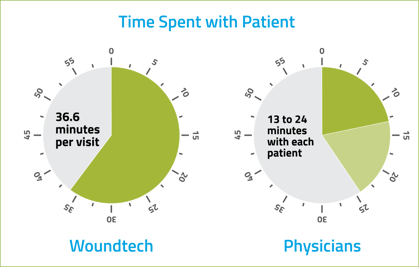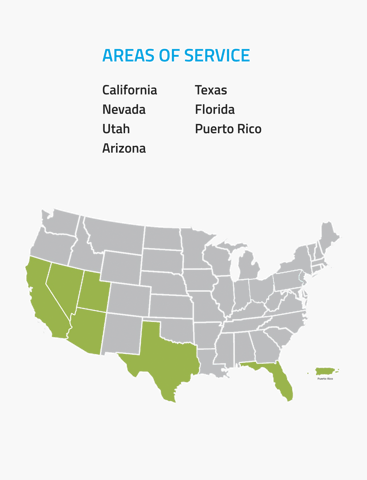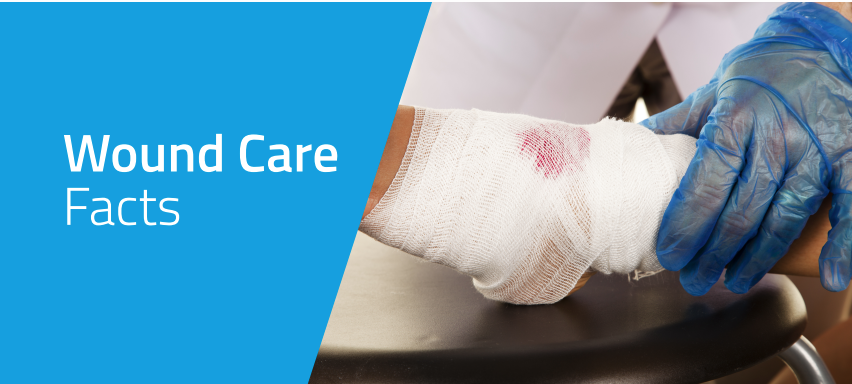Wound Care Facts
Learn about several causes and types of wounds andWoundtech’s approach to advanced wound care. Wound care varies in severity and causes and there are...

Woundtech has determined that time, lack of knowledge, and access to care
has been attributed to the astronomical cost of wound care for decades.
 When patients think of health care the first thing that comes to mind is the high cost of treatment and prescription drugs. According to an article written on the American Medical Association’s website, health spending in the United States
When patients think of health care the first thing that comes to mind is the high cost of treatment and prescription drugs. According to an article written on the American Medical Association’s website, health spending in the United States
increased by 9.7% in 2020, or a $4.1 trillion spend (AMA, 2020). Now, this increase can be primarily attributed to the effects of the COVID-19 pandemic, but health care costs have been on a steady increase for many years. There is an increasing fear among Americans that if the need for health care should arise, they may not be able to afford it. According to an article by CBS News, a third of Americans say they have avoided routine and necessary medical care due to concerns about cost. 23% of Americans say that the cost of health care is a major financial burden due to the increase in deductibles and insurance premiums (Picchi, 2021).
Wound care plays a significant role in these statistics. In Woundtech’s Model of Care white paper, we highlight the fact that 8.2 million Medicare beneficiaries have developed wounds. The estimated cost to Medicare for wound care ranged from $28.1 billion to $96.8 billion (Cole, 2022). With our unique service, we have reduced the time to heal by 20% vs the industry average, while reducing the cost of care from 44% to 72% for various wound types. This results in minimized hospitalizations and amputations.

Woundtech has determined that time, lack of knowledge and access to care has contributed to the astronomical cost of wound care for decades.
Time: Within the health care industry, time is not always on our side, and wound care is no exception. Due to the chain of command, high volume of patients, tight schedules, and lack of communication, it is taking too much time to approve and begin treatment for patients in need of wound care. The start of care is an essential part of determining the time to heal and the cost of wound care. In many cases, due to time constraints, patients do not begin treatment for a minimum of 30 days from diagnosis. In our Late Treatment Case Study, we saw a patient with a 3-year-old chronic diabetic ulcer. We began treatment of the patient 1,102 days after the wound presented itself at a cost of $3,150. This does not include the thousands of dollars spent in the previous three years of treatment. Had we begun treatment at the beginning we would’ve been able to save the patient and health care system thousands of additional dollars.
Woundtech has developed a system to reduce the time to Start of Care. We have contracted with health plans, primary care providers, home health, and other groups to make referring patients easier. By implementing regionalized teams of medical directors, clinicians, patient care coordinators, and case managers we have been able to improve healing rates and quality of life for our referred patients. To learn more about these teams and their purpose follow the link to our Home Page.
 In terms of time, we have discovered that U.S. physicians spend between 13 and 24 minutes with each patient. While Woundtech advanced care clinicians spend an average of 36.6 minutes per visit with our patients, averaging several visits per week. We also spend an average of 50 minutes at the SOC (start of care) date to adequately assess the patient's health, needs, and treatment plan moving forward. This extra time is vital to appropriately treating wounds and improving our patient’s quality of life as we have outlined in our Disparities white paper. With Woundtech’s unique service we are also able to see patients more frequently than home health care or wound care centers.
In terms of time, we have discovered that U.S. physicians spend between 13 and 24 minutes with each patient. While Woundtech advanced care clinicians spend an average of 36.6 minutes per visit with our patients, averaging several visits per week. We also spend an average of 50 minutes at the SOC (start of care) date to adequately assess the patient's health, needs, and treatment plan moving forward. This extra time is vital to appropriately treating wounds and improving our patient’s quality of life as we have outlined in our Disparities white paper. With Woundtech’s unique service we are also able to see patients more frequently than home health care or wound care centers.
The following case studies outline the importance of early referrals and the effects that time play on quality of life and cost of care.
Lack of Knowledge: Statistically speaking, there has been a large amount of inappropriate wound care treatments given to patients due to the lack of knowledge and training in proper wound care treatment causing delayed healing and increased hospitalizations and amputations. Approximately 30% of chronic wounds result in amputation. Wound care is a specialized field of study and expertise. Not all health care workers that treat advanced wounds have proper training or knowledge of wound care types, best practices, or treatments. Our team of clinicians participates in regular training on wound care best practices and are experts in assessing and treating advanced wounds.
Several factors determine how to treat a wound including, but not limited to:
• Nutritional habits
• Medications
• Comorbidities
• Age
• Lifestyle habits
• Type of wound
• Location of wound
 Access To Care: Traditionally wound care is done in a facility like a wound care center, hospital, or by a home health company. Wound care centers are unable to treat homebound patients or patients that are unable to obtain transportation. Hospitals primarily treat infection and try to prevent amputation, then send the patient to a rehab facility or home health care company. Home health care companies cannot treat patients that are not considered homebound and are not always allotted the required time and access to the products necessary to treat more advanced wounds. Woundtech’s unique service allows us to deliver advanced wound care services that meet patients where they are at. We currently serve patients in Florida, California, Texas, Arizona, Nevada, Utah, and Puerto Rico. It is not required that our patient is homebound, rather we feel that their care should be where they are most comfortable and eliminates the cost of transportation and high facility costs for them. Our team of clinicians comprises doctors, podiatrists, physician assistants, and nurse practitioners, making it possible for them to make changes to treatment and write prescriptions in real-time. In turn, this eliminates the need for approval from a providing physician like traditional home health care.
Access To Care: Traditionally wound care is done in a facility like a wound care center, hospital, or by a home health company. Wound care centers are unable to treat homebound patients or patients that are unable to obtain transportation. Hospitals primarily treat infection and try to prevent amputation, then send the patient to a rehab facility or home health care company. Home health care companies cannot treat patients that are not considered homebound and are not always allotted the required time and access to the products necessary to treat more advanced wounds. Woundtech’s unique service allows us to deliver advanced wound care services that meet patients where they are at. We currently serve patients in Florida, California, Texas, Arizona, Nevada, Utah, and Puerto Rico. It is not required that our patient is homebound, rather we feel that their care should be where they are most comfortable and eliminates the cost of transportation and high facility costs for them. Our team of clinicians comprises doctors, podiatrists, physician assistants, and nurse practitioners, making it possible for them to make changes to treatment and write prescriptions in real-time. In turn, this eliminates the need for approval from a providing physician like traditional home health care.
Woundtech is an industry leader in innovation and has a formulary of over 125 advanced wound care products in 14 categories. Our clinicians have full access to this formulary with the help of vTail: Healthcare Telecommunications FormularyFilter. As you can see, our approach is unique to wound care and general health care. We save our patients money by eliminating transportation costs, deductibles, and most copays. We save the providers and health plans money by eliminating their need for wound care product inventory, employment, and resources.
Would you like to submit a referral? Please use the following options to do so.
Phone: 866.986.2263 | Fax: 866.968.6339 | Email: intake@woundtech.net | Portal: Referral Portal
Has this post sparked questions you would like answered? Please Contact Us at your earliest convenience.
References
AMA. (2020). Trends in health care spending. American Medical Association. Retrieved July 19, 2022, from
https:/www.ama-assn.org/about/research/trends-health-care-spending
Picchi, A. (2021, December 14). Surge in Americans skipping medical care due to cost, Gallup says. CBS News. Retrieved July 19, 2022, from https:/www.cbsnews.com/news/health-care-costs-rising-americans/
Cole, W. (2022). The Woundtech Model of Care White Paper.

Learn about several causes and types of wounds andWoundtech’s approach to advanced wound care. Wound care varies in severity and causes and there are...

Who is Woundtech and What Makes us Different In The World of Wound Care?